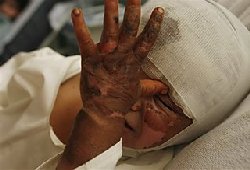White Phosphorus? Concern over burns on Afghans caught in battle
12/05/2009| IslamWeb
Afghanistan's leading human rights organization said Sunday it was investigating the possibility that white phosphorus was used in a U.S.-Taliban battle that killed scores of Afghans. The U.S. military rejected speculation it had used the weapon.
White phosphorus can be employed legitimately in battle, but rights groups say its use over populated areas can indiscriminately burn civilians and constitutes a war crime.
Afghan doctors are concerned over what they are calling "unusual" burns on Afghans wounded in last Monday's battle in Farah province, which President Hamid Karzai has said may have killed 125 to 130 civilians.
Allegations that white phosphorus or another chemical may have been used threatens to deepen the controversy over what Afghan officials say could be the worst case of civilian deaths since the 2001 U.S. invasion that ousted the Taliban regime.
Nader Nadery, a commissioner for the Afghan Independent Human Rights Commission, said officials were concerned white phosphorus may have been used, but he said more investigation was needed.
"Our teams have met with patients," Nadery told The Associated Press. "They are investigating the cause of the injuries and the use of white phosphorus."
White phosphorus is a spontaneously flammable material that can cause painful chemical burns. It is used to mark targets, create smoke screens or as a weapon, and can be delivered by shells, flares or hand grenades, according to GlobalSecurity.org.
Human rights groups denounce its use for the severe burns it causes, though it is not banned by any treaty to which the United States is a signatory.
The U.S. military used white phosphorus in the battle of Fallujah in Iraq in November 2004. Israel's military used it in January against Gazan people.
The U.S. military on Saturday said that Afghan doctors in Farah told American officials that the injuries seen in wounded Afghans from two villages in the province's Bala Baluk district could have resulted from hand grenades or exploding propane tanks.
Dr. Mohammad Aref Jalali, the head of the burn unit at the Herat Regional Hospital in western Afghanistan who has treated five patients wounded in the battle, described the burns as "unusual."
"I think it's the result of a chemical used in a bomb, but I'm not sure what kind of chemical. But if it was a result of a burning house - from petrol or gas cylinders - that kind of burn would look different," he said.
Gul Ahmad Ayubi, the deputy head of Farah's health department, said the province's main hospital had received 14 patients after the battle, all with burn wounds.
"There has been other airstrikes in Farah in the past. We had injuries from those battles, but this is the first time we have seen such burns on the bodies. I'm not sure what kind of bomb it was," he said.
U.N. human rights investigators have also seen "extensive" burn wounds on victims and have raised questions about how the injuries were caused, said a U.N. official who asked not to be identified talking about internal deliberations. The U.N. has reached no conclusions about whether any chemical weapons may have been used, the official said.
Afghan officials say up to 147 people may have died in the battle in Farah.
The investigation into the Farah battle coincides with an appeal by Human Rights Watch for NATO forces to release results of an investigation into a March 14 incident in which an 8-year-old Afghan girl was burned by white phosphorus munitions in Kapisa province.
The New York-based group said Saturday white phosphorus "causes horrendous burns and should not be used in civilian areas."
PHOTO CAPTION
Frishta, 7, an Afghan girl who was badly burned in a US air strike on Monday night in Bala Baluk district of Farah province, cries in a hospital in Herat, Afghanistan, Saturday, May 9, 2009.
Source: Agencies
www.islamweb.net

